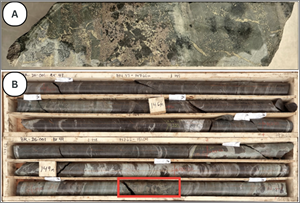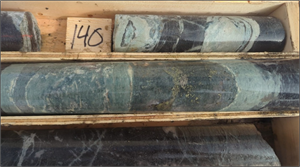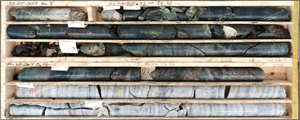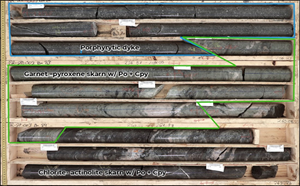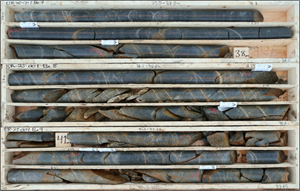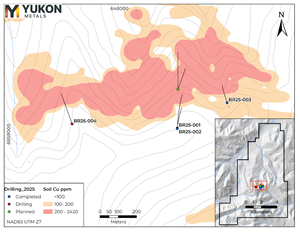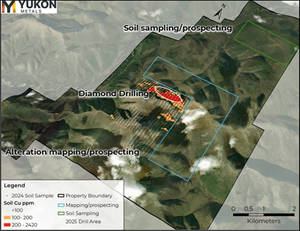VANCOUVER, British Columbia, Sept. 03, 2025 (GLOBE NEWSWIRE) -- Yukon Metals Corp. (CSE: YMC, FSE: E770, OTCQB: YMMCF) (“Yukon Metals” or the “Company) is pleased to provide an update from its exploration activities on its 100%-owned 7,000-hectare Birch Property (“Birch”), located 65 kilometres northeast of Burwash Landing, Yukon, and 200 kilometres northwest of Whitehorse. The 2025 drill program is well underway and has achieved its initial objective of intersecting skarn horizons thought to be responsible for a 1.4-kilometre-long gold and copper in soil anomaly grading up to 0.99 g/t Au and 0.24% Cu, as well as surface rock samples up to 14.1 g/t Au and 2.42% Cu (YMC News Release - October 16, 2024).
Highlights:
- A total of 1,100 metres of diamond drilling has been completed across three pad locations down to depths of up to 400 metres (Figure 7), with all holes intersecting mineralized skarn horizons; assay results are pending.
- Near surface mineralization beginning at ~25 metres, and interval widths up to 46 metres in drill core, includes a thick, continuous interval of intensely skarn altered rock from 256.5 to 302.5 metres: true thicknesses currently unknown.
- The mineralization style suggests the potential for a large, multistage skarn system developed along the marble–schist contacts and intrusive margins.
“Multiple zones of mineralization have been encountered from near surface and substantially at depth. These early results suggest the Birch system has both scale and continuity, and we look forward to receiving assays to help guide the next steps of exploration,” said Rory Quinn, President and CEO of Yukon Metals.
The ongoing diamond drill program at Birch is testing a 1.4-kilometre long and up to 400-metre-wide area of anomalous gold and copper in soil values coincident with mapped limestone, schist horizons, and cross-cutting felsic intrusions.
The 2025 drill program has intersected multiple zones of retrograde skarn mineralization overprinting prograde skarn development with zones of massive garnet. Other rock types include prominent marble units, and multiple phases of cross-cutting intrusive dykes. The thickness of the mineralized zones in drill core, defined by the extent of prograde skarn with pyrrhotite and chalcopyrite present, ranges from 0.2 to 46 metres.
The initial three drill holes at Birch intersected a similar package of interbedded schist, marble, and intrusive dykes that are variably altered:
Hole BR25-001 intersected multiple shallow mineralized horizons, including silicified schist with minor disseminated and vein-hosted pyrrhotite beginning around 60-metre depth, and a broader zone of stronger skarn horizon between 135 to 157 metres with chalcopyrite appearing alongside pyrrhotite in disseminated, vein, and semi-massive textures (Figure 1).
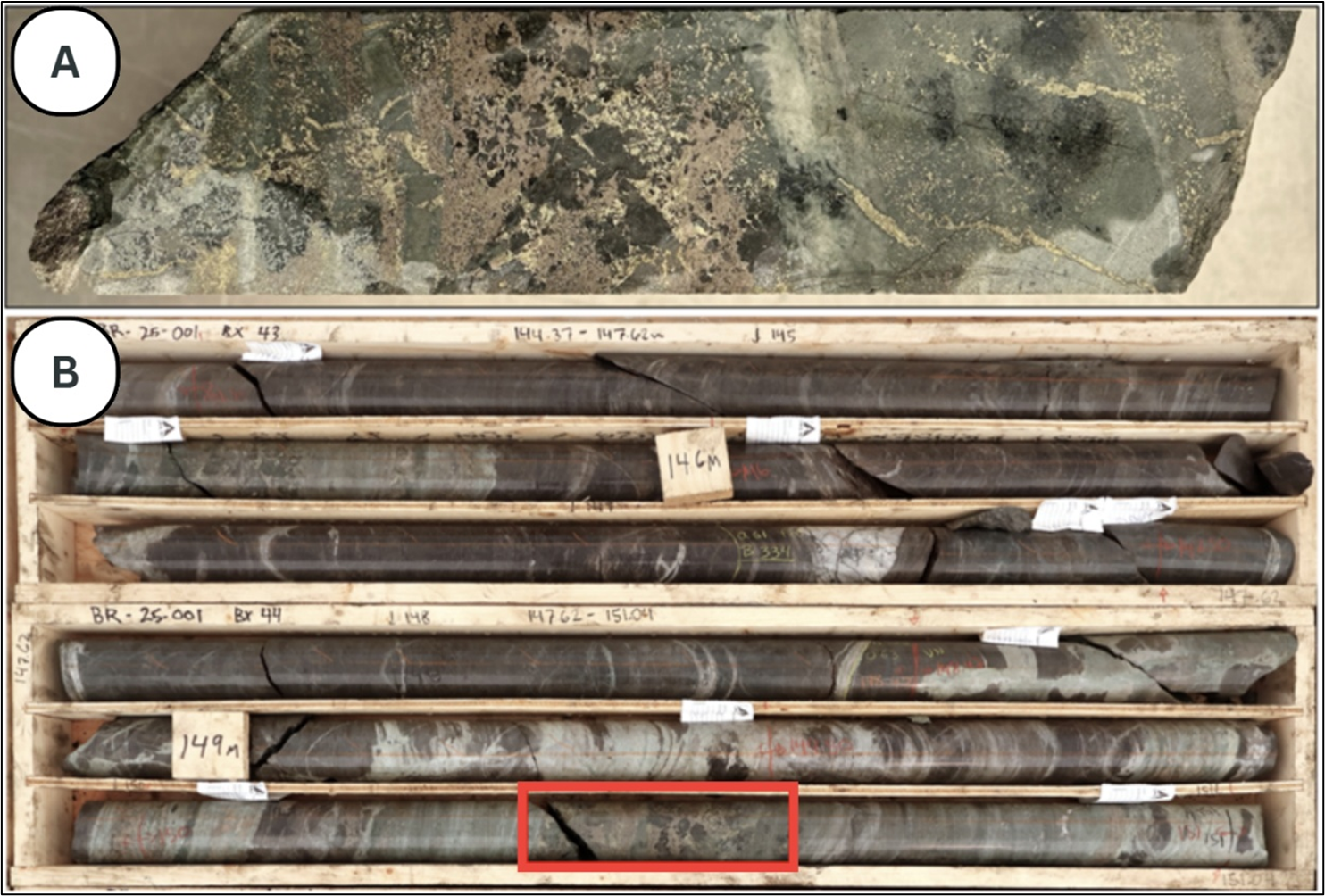
Figure 1 – Hole BR25-001 at 149m. (A) Closeup of massive pyrrhotite > chalcopyrite within skarn horizon. (B) Mineralization within the skarn unit consists of zones of massive sulphides as well as less intense foliaform chalcopyrite.
Hole BR25-002, drilled steeper from the same pad, intersected mineralization as shallow as 50 metres within chlorite–amphibole skarn, continuing through multiple variably mineralized skarn horizons in many cases in association with intrusive contacts. A strongly pyrrhotite-chalcopyrite-pyrite mineralized skarn horizon occurs at 125 metres on the top contact of a granodiorite dyke (Figure 2).
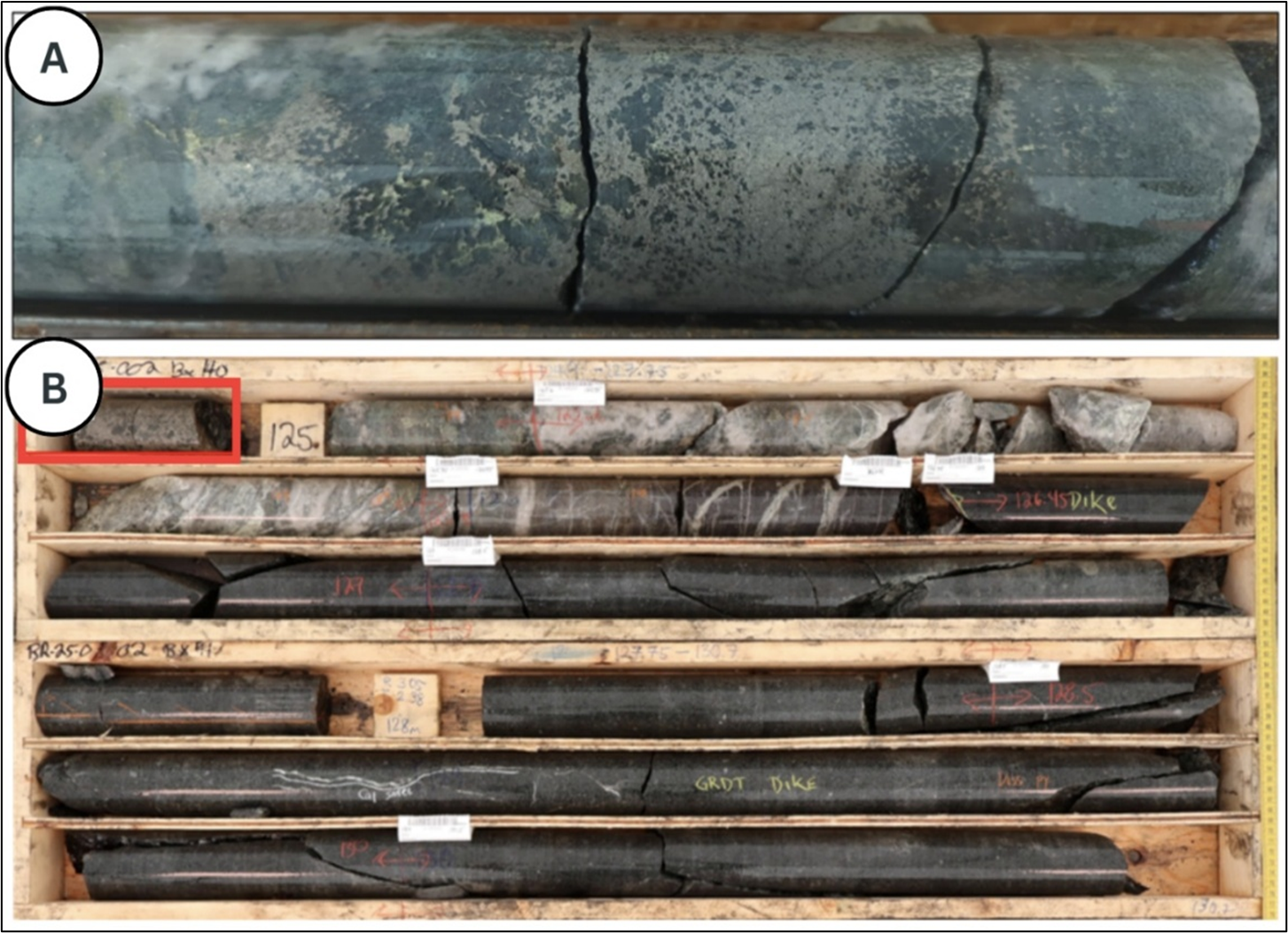
Figure 2 - Hole BR25-002 at 125m. (A) Closeup of massive pyrrhotite > chalcopyrite in skarn zone approaching contact with a thick granodiorite dyke. (B) Mineral assemblage appears to be dominantly chlorite-quartz with zones of massive and clustered sulfide Pyrrhotite > Chalcopyrite, changing to chalcopyrite dominant downhole.
Further downhole it occurs on the bottom contact of a feldspar porphyry dyke unit with chalcopyrite and pyrrhotite (Figure 3).

Figure 3 – Hole BR25-002 at 140m. Mineralized skarn horizon with chalcopyrite > pyrrhotite following a feldspar porphyry dyke unit.
Hole BR25-003, a 250-metre step-out to the east, encountered near-surface mineralization beginning at ~25 metres within skarn along the schist–marble contact (Figure 4) as well as a thick, continuous interval of intensely skarn altered rock from 256.5 to 302.5 metres.
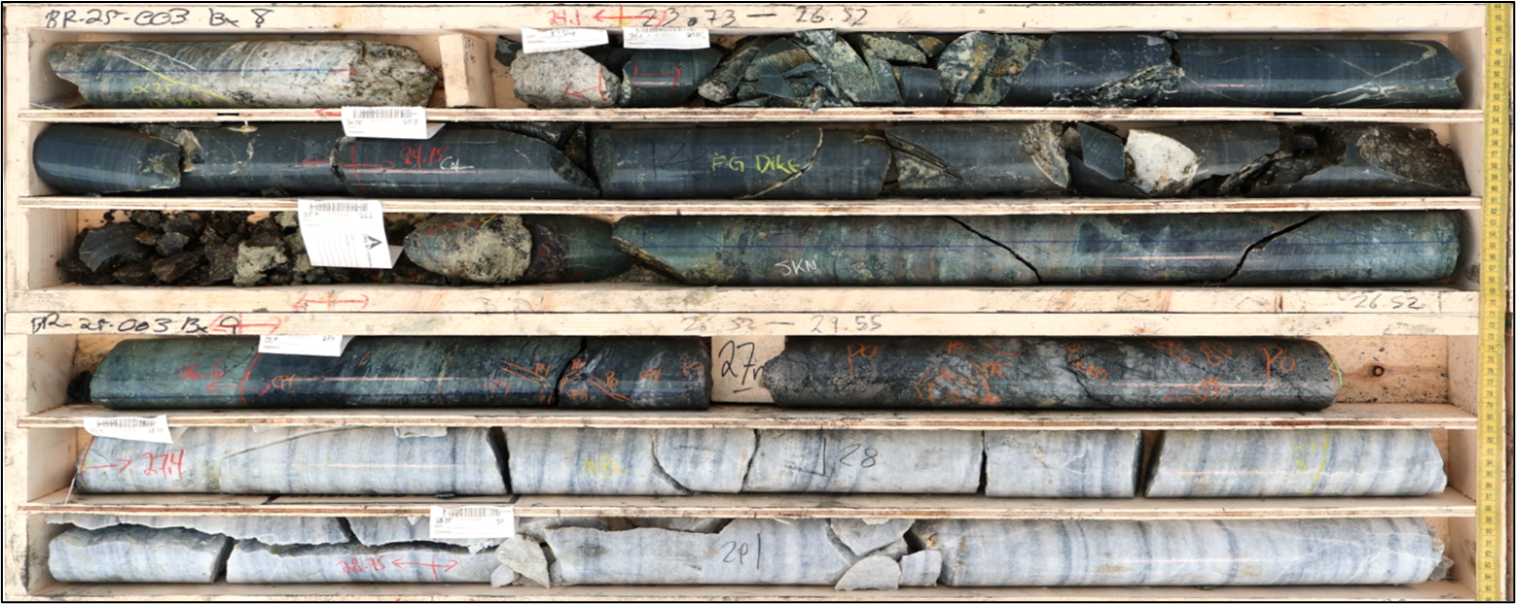
Figure 4 - Hole BR25-003 at 27m, near-surface, strongly developed skarn interval with minor garnet rich horizons and retrograde chlorite-amphibole overprint. Intense massive-mottled Pyrrhotite > Chalcopyrite over ~80cm along contact with marble.
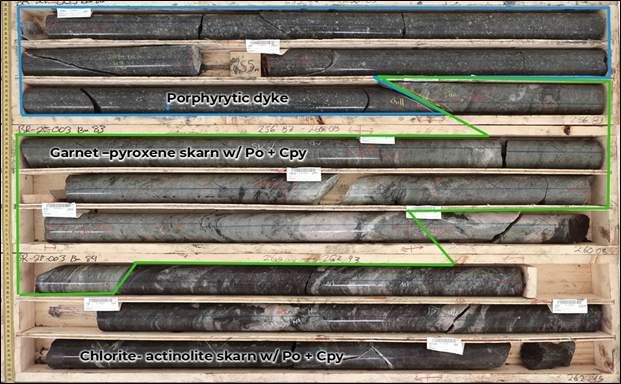
Figure 5 – Hole BR25-003 at 256m. Thick Interval of intensely skarn altered rock with frequent patchy pyrrhotite (Po) +/- chalcopyrite (Cpy) +/- sphalerite. Follows a porphyritic dyke unit with sparse disseminated pyrrhotite.
In addition to skarn-hosted sulfides, BR25-001 and BR25-002 also intersected zones of sheeted quartz-calcite veining above the main skarn horizons (Figure 6), suggesting a broader hydrothermal footprint to the mineralizing system.
Preliminary observations of the drilling show that mineralization is present near surface at shallow depths (~25-metres to 60-metres) as well as in laterally extensive skarn horizons exceeding 20-metres to 40-metres in thickness at depth.
This mineralization style suggests the potential for a large, multistage skarn system developed along the marble–schist contacts and intrusive margins.
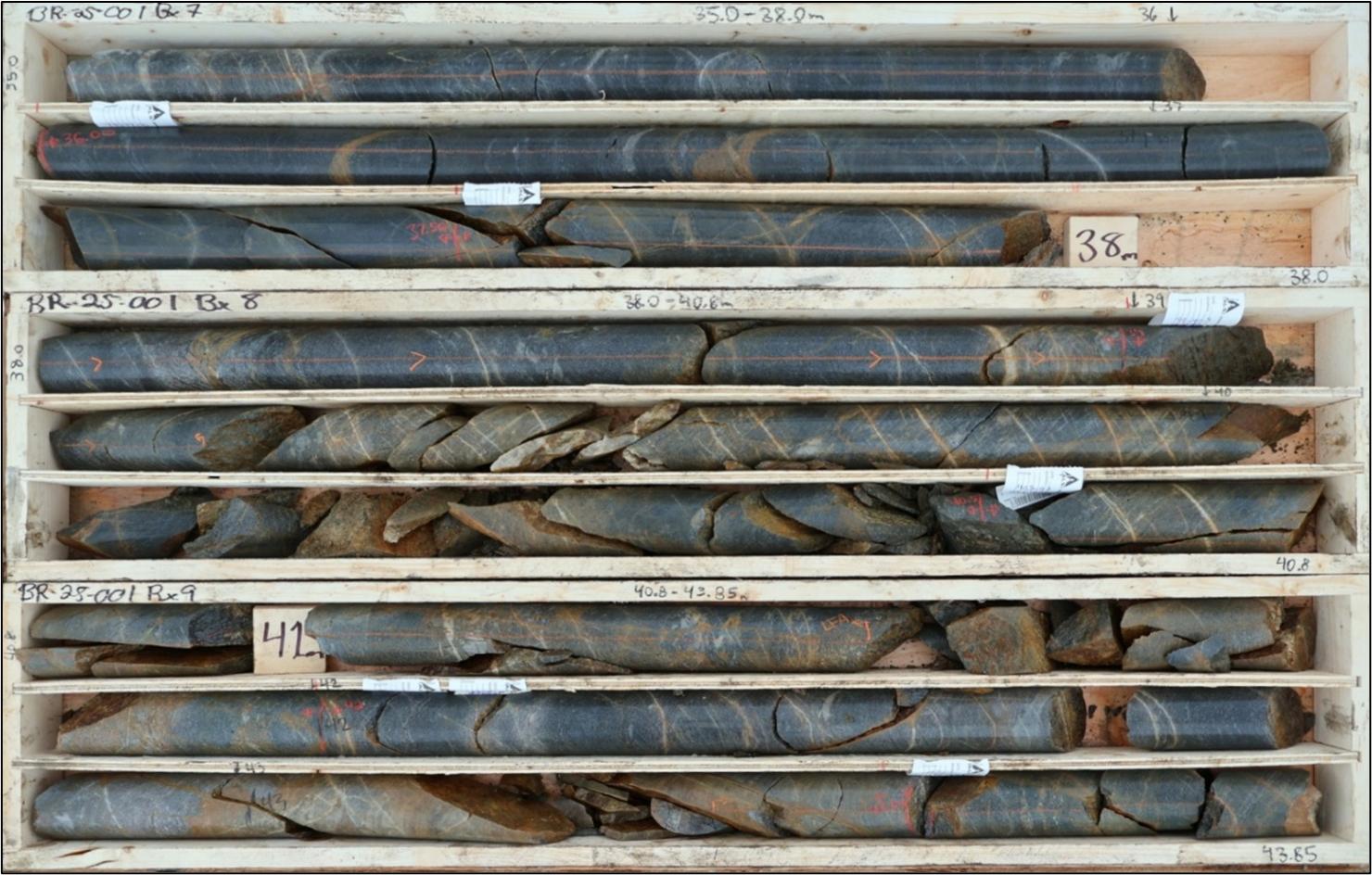
Figure 6 – Hole BR25-001 at 40m. Sheeted quartz-calcite veins cutting through silicified schist unit.

Figure 7 - 2025 Drilling Locations at Birch Property.
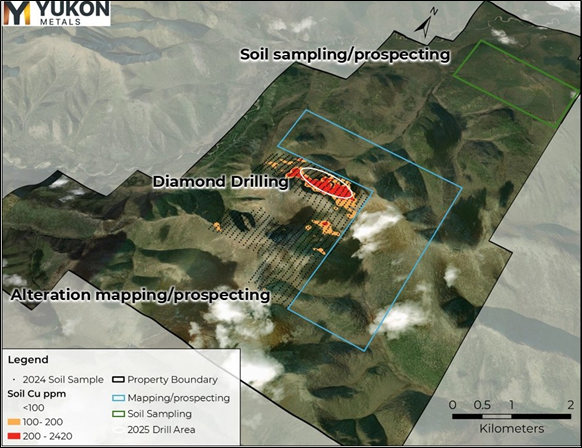
Figure 8 - Map of 2025 planned exploration work at Birch Property.
About the Birch Project
Yukon Metals owns 100% of the helicopter-accessed Birch project located 65 kilometres northeast of the community of Burwash Landing. The Birch project area is dominated by frost-heaved boulders in unglaciated terrain, with outcrop present on steeper ridges. The project lies predominantly within the Finlayson assemblage of the Yukon-Tanana Terrane, consisting of variably carbonaceous schist and quartzite, marble, garnet amphibolite and rare metaplutonic rocks.
The Yukon-Tanana Terrane structurally overlies the Ruby Range Batholith which is regionally mapped in the northeastern portion of the property occurring as Ruby Range quartz-feldspar porphyry and Rhyolite Creek porphyry and intermediate and felsic volcanic rock (Israel et. Al., 2011). Project-level mapping indicates the geology of the area is comprised of schists and marble units, moderately to strongly oxidised felsic intrusive, and patchy oxidised porphyritic rhyolite dykes.
About Yukon Metals Corp.
Yukon Metals is a well-financed exploration company with a 17-project portfolio covering more than 43,000 hectares. Built on over 30 years of Berdahl family prospecting, the same team behind Snowline Gold’s district-scale assets, YMC provides exposure to copper, gold, silver, and critical metals. While advancing high-priority drill targets at the AZ and Birch copper-gold systems and the Star River gold-silver-copper project, the Company is also conducting generative exploration across its broader portfolio to develop the next pipeline of discovery opportunities. Guided by an experienced leadership team with technical, financial, and Yukon expertise, the Company is well positioned to unlock new mineral discoveries across the Yukon territory.
Yukon Metals is committed to fostering sustainable growth and prosperity within Yukon’s local communities, while also enhancing shareholder value. Rooted in a philosophy of inclusiveness and shared prosperity, the Company’s strategy offers both local community members and investors the opportunity to contribute to and benefit from its success.
Yukon-based and Local First Nation Contractors Engaged
Diamond drilling at the Birch project is operated by New Age Drilling Solutions, a Yukon-based contractor, in partnership with Vision Quest Drilling, a Kluane First Nations citizen-owned company. Camp support services for the exploration activities is being provided by Käganì, a Kluane First Nations citizen-owned enterprise in partnership with longstanding Yukon-based exploration contractor, Archer Cathro.
QAQC
Diamond drill core from the 2025 program at the Birch project is in the process of being logged, photographed, and sawn in half using a diamond-blade core saw. One half of the core will be submitted for geochemical analysis, while the other half will be retained for future reference.
Prospecting rock samples in 2024 were sent to ALS Minerals for analysis with sample preparation in Whitehorse, Yukon and analysis in North Vancouver, British Columbia.
Rock samples taken while prospecting referenced in this release are selective in nature and collected to determine the presence or absence of mineralization and may not be representative of the mineralization hosted on the project.
Qualified Person
The technical content of this news release has been reviewed and approved by Helena Kuikka, P.Geo., VP Exploration for Yukon Metals and a Qualified Person (as defined by National Instrument 43-101).
The Yukon
The Yukon remains one of the world’s last underexplored mineral belts, offering exceptional discovery potential. The Territory is home to a highly skilled and conscientious local workforce, shaped by generations of exploration experience coupled with a deep respect for the land.
Recent major discoveries with local roots, such as Snowline Gold’s Rogue Project - Valley Discovery, highlight the Yukon’s potential to generate fresh district-scale mining opportunities.
ON BEHALF OF THE BOARD OF YUKON METALS CORP.
“Rory Quinn”
Rory Quinn, President & CEO
Email: roryquinn@yukonmetals.com
For additional information please contact:
Kaeli Gattens
Vice President, Investor Relations & Communications
Yukon Metals Corp.
Email: kaeligattens@yukonmetals.com
Phone: 236-466-9837
CAUTIONARY NOTE REGARDING FORWARD-LOOKING INFORMATION
This news release contains certain forward-looking information, including information about the metal association and geology of the prospect area at Birch pointing to the prospectivity for a gold-rich copper porphyry system, significant scale having been demonstrated by a soil anomaly over 1,400 metres long, the potential for economic grades of copper and gold based on grades taken from surface rock chips, the Yukon’s potential to generate fresh district-scale mining opportunities, and the Company’s future plans and intentions. Wherever possible, words such as “may”, “will”, “should”, “could”, “expect”, “plan”, “intend”, “anticipate”, “believe”, “estimate”, “predict” or “potential” or the negative or other variations of these words, or similar words or phrases, have been used to identify the forward-looking information. These statements reflect management’s current beliefs and are based on information currently available to management as at the date hereof.
Forward-looking information involves significant risks, uncertainties and assumptions. Many factors could cause actual results, performance or achievements to differ materially from those discussed or implied in the forward-looking information.
Such factors include, among other things: risks and uncertainties relating to Birch not being a prospective gold-rich copper porphyry system, not having significant scale and a lack of economic grade minerals; the Yukon not having the potential to generate fresh district-scale mining opportunities; and other risks and uncertainties. See the section entitled “Risk Factors” in the Company’s listing statement dated May 30, 2024, available under the Company’s profile on SEDAR+ at www.sedarplus.ca for additional risk factors. These factors should be considered carefully, and readers should not place undue reliance on the forward-looking information. Although the forward-looking information contained in this news release is based upon what management believes to be reasonable assumptions, the Company cannot assure readers that actual results will be consistent with the forward-looking information. The forward-looking information is made as of the date of this news release, and the Company assumes no obligation to update or revise the information to reflect new events or circumstances, except as required by law.
References
Israel, S., Murphy, D., Bennett, V., Mortensen, J. and Crowley, J., 2011. New insights into the geology and mineral potential of the Coast Belt in southwestern Yukon. In: Yukon Exploration and Geology 2010, K.E. MacFarlane, L.H. Weston and C. Relf (eds.), Yukon Geological Survey, p. 101-123.
Photos accompanying this announcement are available at:
https://www.globenewswire.com/NewsRoom/AttachmentNg/1811127e-a0cb-4dd5-aad8-0a186cf6027b
https://www.globenewswire.com/NewsRoom/AttachmentNg/a4ceadde-10ae-4fe9-aaf7-7d313ac8cabd
https://www.globenewswire.com/NewsRoom/AttachmentNg/b80e859f-e598-4468-ba73-71f8275ae113
https://www.globenewswire.com/NewsRoom/AttachmentNg/76572e08-b446-495e-828c-396ca28a3660
https://www.globenewswire.com/NewsRoom/AttachmentNg/3e44737e-9044-4d18-b6d6-1972faef9e1f
https://www.globenewswire.com/NewsRoom/AttachmentNg/ac3480fa-b782-4fb4-bab7-ca0df762b27d
https://www.globenewswire.com/NewsRoom/AttachmentNg/27351f98-0751-4ccb-841b-22e958925ef6
https://www.globenewswire.com/NewsRoom/AttachmentNg/d259b898-089f-4d12-a499-042b8471a66c






